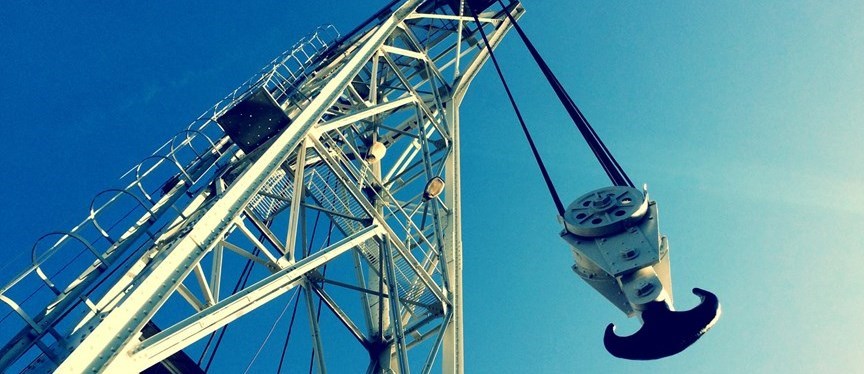Cranes - part of the cultural heritage

There have been many different designs of cranes. Gantry cranes, tower cranes, container cranes, pontoon cranes, medieval cranes of various types, cranes on trucks and ships, large cranes and small cranes with all possible variants. The list is long. One of the most common cranes in Sweden, from the early 20th century to the present day, was the portal boom crane, purchased by almost every port worth its salt. It was a clear landmark for a city, with an austere look toward the future.
A good example of this type of crane is the one in Vänersborg, built in the expansive period immediately after the Second World War. European industry lay in ruins while Swedish industry was full speed ahead. Ports were modernised, larger and deeper draught ships were built, and the pressure of efficiency in ports increased. No more carrying of barrels and sacks on rickety, wet gangplanks! The ear of small cargo boats time is over. Modern ships and harbour cranes have taken over jobs that broke many backs and the new age is ahead of us, shiny as a newly polished floor. Dizzying new heights will be reached in Sweden's welfare state!
The Aarhus crane: Danish and affordable
After the war, far-sighted local politicians in Vänersborg decided to purchase a portal boom crane for the port. The order went to a Danish company, Aarhus Maskinfabrik AS, which could deliver a crane in half the time required by Swedish companies with full order books, and at a better price. "But we've not compromised on quality," it was said in the corridors of the town hall, and they wrote detailed and complete specifications of how the new crane should be equipped.
The work environment in the control cab was specified with a brief sentence at the end of the documents. It stated that the controls should be placed so that they would be easily accessible for the person operating the crane. Even today, that can surely be seen as a reasonable requirement! After some correspondence back and forth between the municipality and the manufacturer, including the issue of which currency the payment would be made in, the crane was delivered in 1948. Ever since that date, for almost seven decades it has done sterling work in lifting many varieties of goods on and off ships.
The crane and the city skyline
Over the years, people have passed the port crane in trains, on bridges, on the canal and so on, and may not have given much thought to its significance. New modes of transport and changing social structures have made the crane unemployed, and the passage of time has also started to be noticeable. As we all know, the future catches up with us and 2016 was the time of the port crane's swan song. But wait a moment! What will it look like when the crane has gone? Suddenly we notice that something isn't right. We are missing something!
What we have accepted as a natural part of everyday life has suddenly disappeared. The ground beneath our feet is almost cracking and Vänersborg is missing another silhouette. But it is not yet too late; the crane is still there, waiting for new tasks. No longer lifting boxes of colonial commodities, filled with oranges, kiwis and other goods to enrich our lives, but to tell its story – what the crane symbolises, a successful period in the history of Vänersborg when all ports toward the future were wide open.
Many cranes preserved
Are there any port cranes that are still preserved, asks the inquiring citizen. Yes, there are many good examples of port cranes becoming part of our cultural heritage long after the last box of bananas was lifted off the ship. Luleå, Örnsköldsvik, Halmstad, Karlskrona, Visby, Trollhättan, Gothenburg, Stockholm and tiny Forsvik are examples of places that have preserved one or more port cranes. They vary from the small factory crane by the Göta Canal in Forsvik, dated 1889, to the gigantic gantry crane in the Eriksberg area in Gothenburg, built in 1969.
It is not a simple task to preserve a port crane and, it must be admitted, is not cheap to maintain what is, in effect, only a huge symbol of our shared past. The question is rather; can we afford not to do it? Nobody would imagine closing Läckö Castle, or filling in the Göta Canal to replace it with a skateboard track because operations and maintenance are too expensive?
The "Russia" crane, freshly painted and reconditioned
The decision was taken in Trollhättan to seize the opportunity and keep the Russian crane. It was a particularly well-considered decision and the result is now there for all to see, freshly painted and reconditioned, to the benefit of keen joggers, trendy cyclists, sauntering flâneurs or healthy outdoor types in boats on Lake Åkers. The Russia crane is now a strong symbol of Trollhättan with the wind in its sails. It is a symbol and an exclamation mark for an exciting period in Trollhättan's history. With this piece from the past, who could possibly miss the story of 1000 locomotives exported to Russia and the major political manoeuvring prior to the deal?
Contact
The text above were written by the curator Hans Hellman, who specialises in the industrial cultural heritage: "It is about cranes, very much due to my particular approach to the technical cultural heritage. Port cranes in this case are a vital part of the logistics in modern society, as well as often being an important landmark in many urban areas."
Phone: 070 - 694 14 75
E-mail: hans.hellman@vgregion.se





